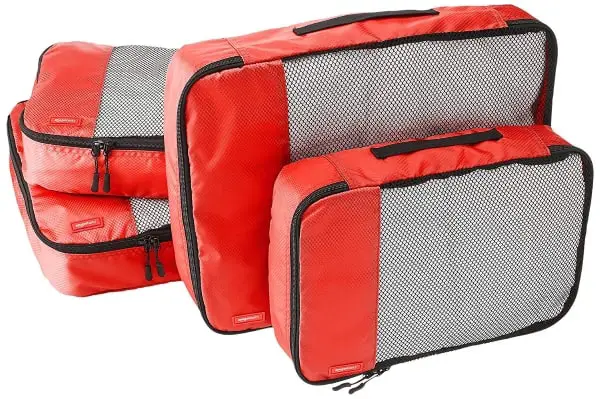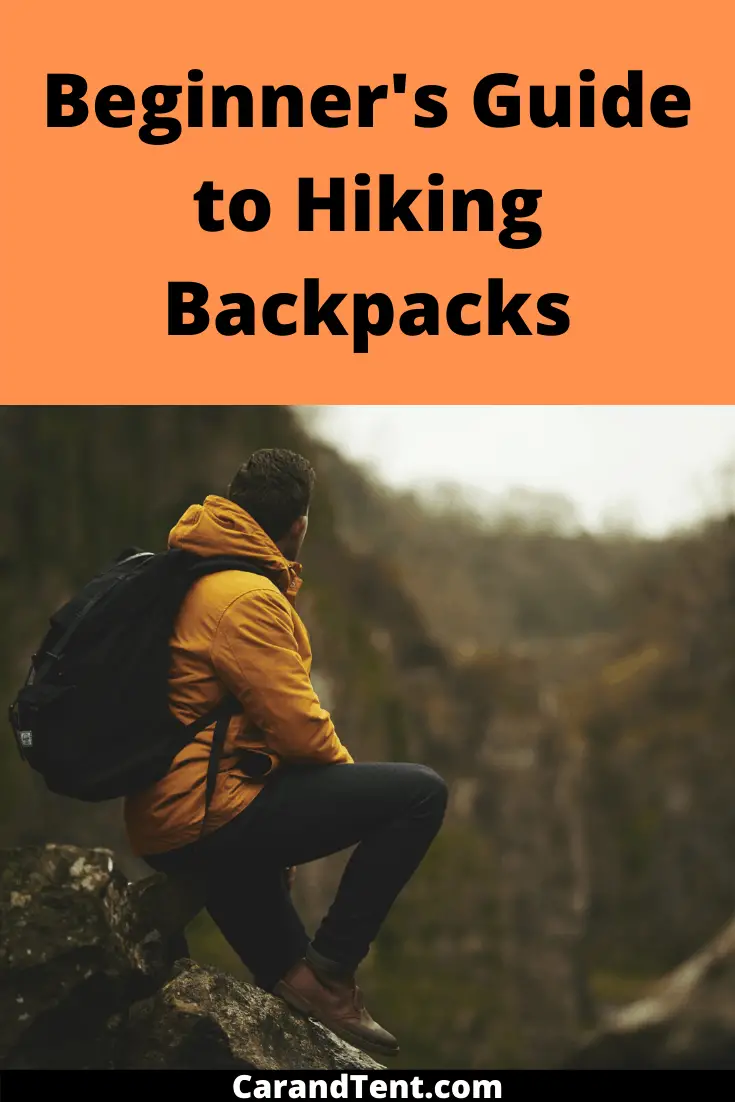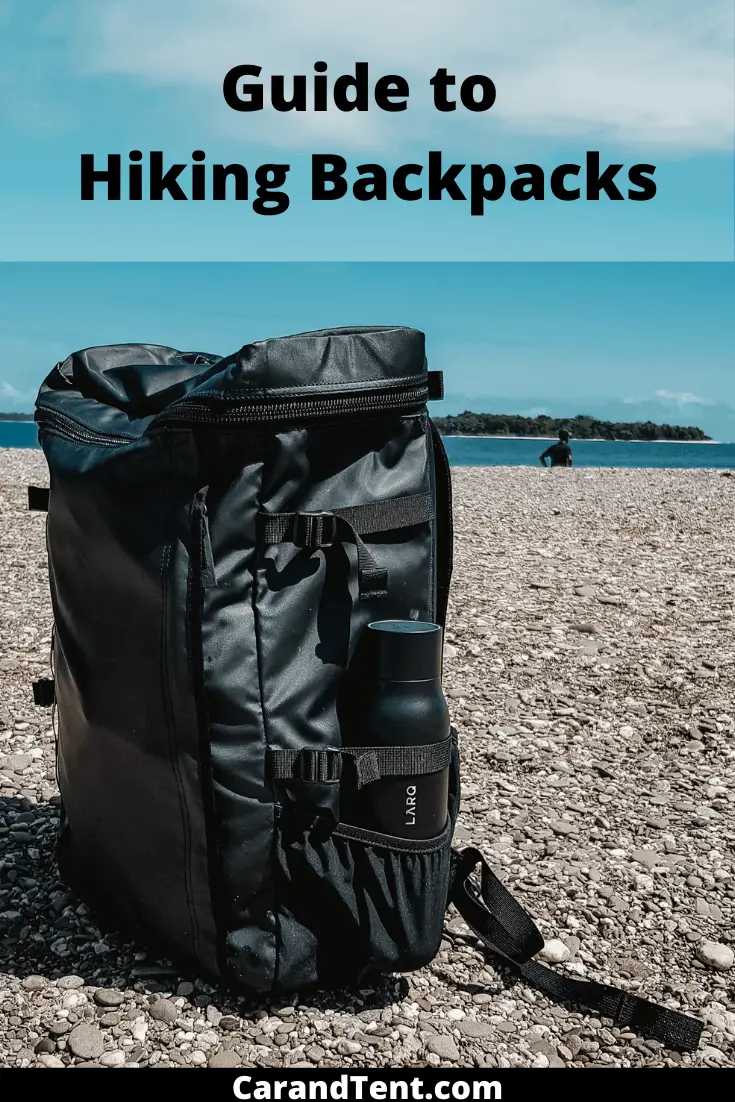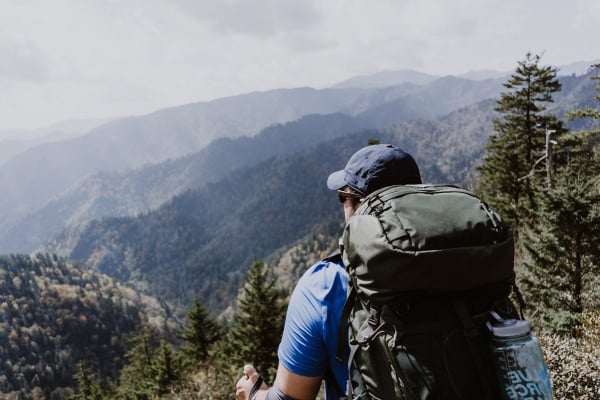
Hiking backpacks are better now than they’ve ever been. This is because of innovations in the way they’re built, the materials they’re built with, and the way they’re designed.
Unfortunately, this has also made them more complicated to buy than ever before. In this guide to hiking backpacks, I’ll try to make things easier.
Table of Contents
Types of Hiking Backpacks
There are three main types of hiking backpacks for you to consider. These are external frame hiking backpacks, internal frame hiking backpacks, and frameless hiking backpacks.
The type of backpack you choose will be determined mostly by your particular needs as well as your budget. Let’s talk about each of these types so that you can decide which one is best for you.
External Frame Hiking Backpacks
The external frame hiking backpack has been around for quite some time. If you’ve ever watched an old war movie, these are the types of backpacks that you saw the soldiers carrying.
This type of backpack consists of a metal frame with a pack strapped to it. It usually consists of several different compartments and you can choose to hang additional gear off of the pack. The frame will usually have a belt strap as well as shoulder straps connected to it as well.
Here are the advantages and disadvantages of these backpacks.
Advantages of External Frame Backpacks
- Less expensive than other types of backpacks.
- Can hold a lot of gear.
- Has a multitude of compartments.
External frame backpacks are usually significantly less expensive than internal frame backpacks and frameless backpacks. They can also hold a lot of gear both inside and outside of them. This is great for somebody looking to carry a large sleeping bag and a sleeping pad outside of their backpack.
These backpacks usually have a lot of different compartments that can be accessed from different areas of the backpack. This makes it easier to organize the backpack and makes it so that you don’t have to empty the entire backpack out each time you go to retrieve something from it. When you’re hiking many miles with frequent breaks, this can be especially advantageous.
Disadvantages of External Frame Backpacks
- Bulkier.
- Less comfortable.
- Less waterproof.
An external frame backpack is bulkier which makes it harder to pack in a vehicle and harder to get in and out of a tent. It also makes it more likely to get snagged on tree branches while hiking on narrow trails.
These backpacks also tend to fit more poorly than other types of backpacks. This makes the bag less comfortable to wear.
On top of this, most external frame backpacks are not waterproof. As a result, you’ll either have to cover them or place the contents of the bag inside of waterproof bags.
When I was in the military, we were issued a wet-weather bag to put inside of our external frame rucksack. This worked but it was annoying as you had to open two bags each time you wanted to get something out.
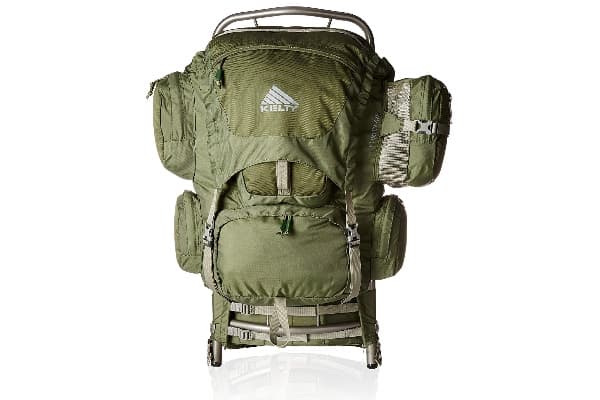
Internal Frame Hiking Backpacks
An internal frame backpack consists of a pack with plastic sewn into it to provide a rigid structure that is used to replace the typical frame you’d find on a backpack. Because the frame is built into the backpack, additional gear cannot be hung onto the outside of the pack without additional features.
Internal frame hiking backpacks started out as mountaineering backpacks. This is because the internal frame was less likely to snag on rocks and ice.
In recent years, this type of backpack has started to replace the external backpack typically found on hiking trails. This is probably a result of the popularity of ultralight gear and supported hikes.
Advantages of Internal Frame Hiking Backpacks
- More Comfortable
- More Compact
- Lighter
Internal frame hiking backpacks confirm better to a hiker’s body. They can also be adjusted more easily than external frame backpacks. This makes these packs more comfortable to wear.
The lack of a bulky external frame makes an internal frame backpack a lot more compact. This means hikers don’t have to worry about the frame getting caught on rocks and tree branches. It also makes passing other hikers easier as you don’t have to worry as much about getting your packs stuck together on passing.
Plastic internal frames are usually smaller and lighter than metal external ones. This cuts down on the weight of the pack, which can be very important on a long hike.
Disadvantages of Internal Frame Hiking Backpacks
- Cost
- Space
- Lack of Compartments
An internal frame pack is usually more expensive than an external one. The reason for this is that an internal frame backpack is usually engineered better than an external one. Also, the plastic components used to create a high-end internal frame backpack can often be much more expensive than the aluminum frames used on external frame backpacks.
Internal frame packs have less space to offer than external ones. For starters, the pack itself loses space to the internal frame. On top of this, the external frame that people would normally hang their gear on no longer exists so a massive amount of space can be lost there.
This type of backpack also lacks storage compartments. The reason for this is that the pack is often designed with a single large opening at the top of it. This gives the pack great weight distribution but also makes it a chore to get gear in and out of it.
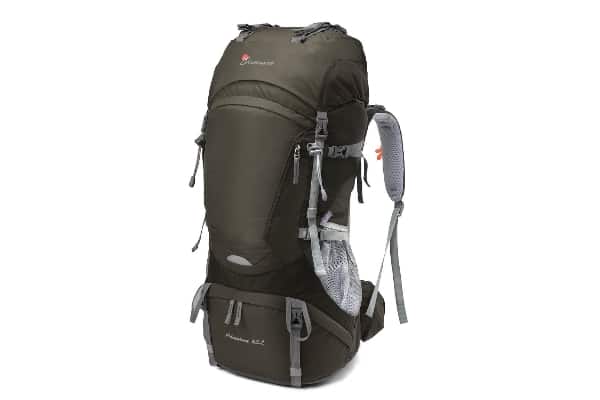
Frameless Hiking Backpacks
A frameless hiking backpack is exactly what you think it would be. This is a backpack that consists of just a bag, shoulder straps, and sometimes a belt strap. These backpacks do not have a frame at all and do not provide much support.
Advantages of Frameless Hiking Backpacks
- Lightweight
- Inexpensive
- Easy to Pack
The frames of hiking backpacks are usually the heaviest part of the backpack. Taking them out of the equation can drastically cut the weight of the backpack down.
Backpacks with frames are usually engineered and the frames themselves are usually made from high-quality materials. Taking these frames out makes the backpack a lot less expensive. It also makes it easier to pack into a vehicle as the missing frame gives them the ability to be packed down flat.
Disadvantages of Frameless Hiking Backpacks
- Lack of Support
- Lack of Carrying Capacity
A frameless hiking backpack does not offer much support to the wearer. Without a frame, the weight can’t be distributed so all of the weight is basically hanging from the hiker’s shoulders.
Because these backpacks lack support, the amount of weight that can comfortably be carried in them is very limited. Most backpackers would agree that you wouldn’t want to carry more than 15 or 20 pounds of gear in a frameless backpack.
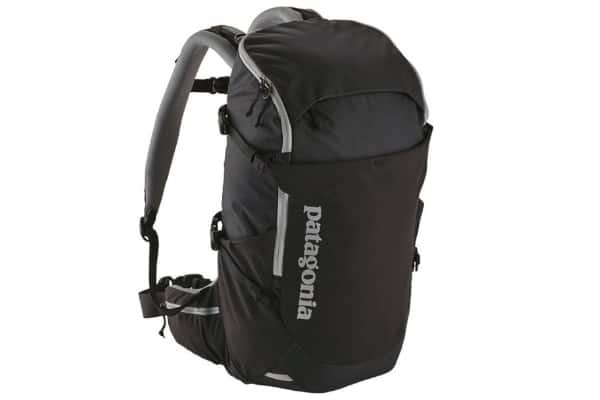
Sizing a Hiking Backpack
Unfortunately, most backpacks are not a one-size-fits-all solution. Backpacks need to be sized and fitted to the person using it, otherwise, the weight inside of the backpack will not be re-distributed to the hips.
To size a hiking backpack, you’ll just need two measurements. The first one is the length of your torso and the second one is the width of your hips.
Taking these measurements is easy to do. Start by standing up straight and slightly tilting your head forward.
Next, have a friend measure from the bump at the back of your neck, down the center of your back to where your hips are. Some people recommend you place your hands on your hips to help provide a visual reference for your friend. The measurement you find here is your torso measurement.
After this, you just need to use a tailor’s tape to measure around your hips. Most hip belts are highly adjustable so as long as your torso measurement is correct, you probably won’t have any problems with the hip belt not fitting but it is a nice measurement to have just in case.
Fitting a Hiking Backpack
Once you have your measurements, you can buy the right size backpack for your body. However, just because the backpack is sized correctly, it doesn’t mean that it will automatically fit correctly.
Backpacks will often come with an adjustable torso and an adjustable waist belt. You’ll also be able to adjust the shoulder straps as well as the strap that crosses over your upper chest.
Every backpack is different but you should be able to figure out how to re-adjust these straps just by looking at them. Take your time to get them set up correctly so that the waist belt sits directly over your hips and redistributes your backpack’s weight down to your legs.
Men’s Hiking Backpacks Vs Women’s Hiking Backpacks
Many people wonder what the difference is between a man’s hiking backpack and a woman’s hiking backpack. The main difference between the two is the sizing.
Men tend to have longer torsos and hips that are more narrow. Because of this, a man might find that a woman’s backpack won’t have a long enough torso and women might find that a backpack that fits their torso might not fit their hips as well.
Another difference is that women’s packs tend to have narrower shoulder straps. This difference can make a big impact for men with particularly large shoulders attempting to wear a woman’s pack or a woman with particularly narrow shoulders attempting to wear a man’s pack.
This being said, some people may find that a pack built for the opposite sex might fit them better. It really all depends on your body type so it’s important that you take measurements to determine what body size you actually have.
You’ll also find that some companies sell unisex packs. In this case, you’ll just need to pay careful attention to the sizing to determine what pack will work best for you.
How Large Does My Hiking Backpack Need To Be
The size of your hiking backpack will be determined by how much gear you actually need to carry. The amount of space your gear takes up will be determined by many factors.
These factors include:
- The length of your hiking trip.
- The weather.
- Your access to water.
- Your number of re-supply points.
- The size of your gear.
In most cases, the longer your trip is the more gear, food, and water you’ll need to pack. This is especially true for people who will be backpacking through different terrains and micro-climates.
For example, a person hiking the John Muir trail will hit elevations of over 14,000 feet. If you’ve read my post titled, “Quick Guide to Hiking Up a Mountain“, you know that the temperatures will be much lower at such elevations. This means you’ll end up having to pack warm weather clothing as well as cold weather clothing.
Even if the climate doesn’t change over the course of your hiking trip, you’ll still find that the weather will dictate how large your backpack needs to be. This is because cold-weather gear simply takes up more space.
You’ll also find that your access to water and the number of re-supply points will determine your backpack’s size. People with fewer places to get food and water will just need to bring more food and water with them.
On top of all of this, some people have larger gear than others. For instance, ultra-light hikers tend to buy gear that weighs less and takes up less space. This gear is more expensive but it does often mean you’ll get to carry a smaller backpack.
Sizes to Choose From – Guidance for Choosing a Backpack
Backpacks are sized by the volume they can hold. This volume is measured in liters. Smaller day packs might range anywhere from 6 – 30 liters in size. A 6-liter pack won’t hold much more than a sandwich and a bottle of water while a 30-liter backpack can hold everything you need for the day as well as some emergency gear that you might want to consider bringing with you on more difficult hikes.
Backpacks between 30 and 50 liters are considered medium-sized backpacks and they’re great for weekend adventures as well as extended day trips. Ultralight backpackers with frequent access to water may also consider them for longer trips as well.
A pack that is larger than 50 liters is what you’ll see backpackers who take longer trips use. Weekenders camping out in cold weather may also consider going with a 50+ liter backpack.
If you’re just getting into hiking, you might want to start off by choosing a large daypack. You can use this daypack on your day hikes and with some careful planning, you can also take it out on fair-weather weekend adventures. Once you’ve become more experienced with backpacking, you can then upgrade to a larger backpack for cold-weather backpacking as well as longer adventures.
Special Features to Consider
Modern backpacks come with a wide array of special features that you might want to consider. Some of these features include.
- Modular Components
- Built-in Hydration Bladders
- Hip Belt Pockets
- A Built-in Rain Fly
- Ventilation
Modular Components
Some hiking backpacks will have separate components that can come off to be used separately from the main backpack. For example, some backpacks will have a smaller backpack that clips onto the back of the pack. This smaller bag can be used with the backpack or by itself as a daypack.
Other backpacks will have waist belts that can be taken off of the backpack and used by themselves. These waistbelts will usually have pockets or a small bag connected to them which is great for carrying small items on short trips.
Hydration Bladders
A hydration bladder is usually worn by itself, within, or underneath a backpack. These hydration bladders make it much easier to carry large amounts of water on long hikes.
In fact, hydration bladders have become so popular that many backpack manufacturers have built them into their backpacks. This gives the hydration bladder a custom fit so the bladder and the backpack work perfectly together.
Hip Belt Pockets and Rain Flies
Placing pockets into the hip belt is useful on both modular backpacks as well as stand-alone packs. These pockets are great for storing snacks and small maps because they can be accessed without the wearer having to put their backpack down.
Built-in pockets aren’t just great for hip belts, they’re also great for storing a rain fly. Oftentimes, newer backpacks will have a zip pocket at the top that houses a rain fly. This rainfly, also known as a rain hood, comes out of the pocket and acts as a rain fly for the rest of the backpack. It’s a great feature that works well even in a downpour.
Ventilation
Backpacks can become very hot over time. This is especially true for internal frame backpacks. The reason for this is that these types of backpacks hug the wearer’s back tightly.
To get around this, many backpacks have built a ventilation layer into their packs. This comes in the form of a mesh material that sits between the wearer and the rest of the backpack. The mesh allows air to pass between the backpack and the wearer’s back and can drastically reduce sweat build-up.
Hiking Backpack Accessories
There are a few different types of accessories you might want to consider adding to your backpack. Some of these accessories include:
- Add-on Pockets
- Bear Canisters
- Bear Spray Holsters
- Carabiners
- Helmet Holders
- Laptop Sleeves
- Pack Pods
- Rain Covers
- Waterproof Liners
Add-on pockets are small packs that clip onto your existing bag. They use straps and are meant to fit snuggly onto your pack so that they do not bounce around while you’re hiking.
Bear canisters are containers that are meant to store food so that bears and other animals cannot get to it. These canisters should come out of your backpack each time you stop for the night.
Bear spray holsters are typically meant to fit onto the side or front of your backpack so that you can quickly and easily access your bear spray. These holsters can also be placed onto your belt as well.
A carabiner makes it easy to hook other items to your backpack. This is especially true for people using external frame backpacks.
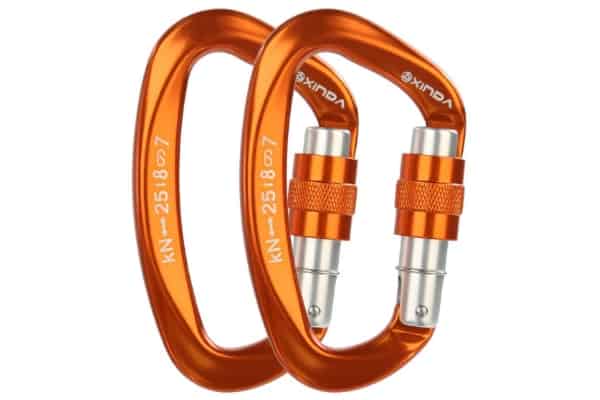
Helmet holders are meant to fasten your helmet to the back of your pack. These items work well because of their ability to be tightened close to the pack. They are also great for people who want quick access to their helmets as they can usually be unclipped just by unhooking a buckle or two.
Laptop sleeves are just padded sleeves that you can put your laptop into so that it is protected from the rest of your gear. You’ll still have to be careful with your laptop but the sleeves will at least provide some protection against small impacts.
Pack pods are just small cases that you can put inside of your backpack to help organize your gear. Typically, these cases come in different colors so you can use them to color-code your backpack’s gear.
You can get the pack pods above through this affiliate link: https://amzn.to/3u9q4ej
A rain cover can be used to go over your backpack to protect it from getting wet. These are great for people who do not have a built-in rain fly.
Waterproof liners are waterproof bags that go inside your backpack. You can buy these in a multitude of different sizes and colors as well.
Don’t go overboard with buying accessories right away. Stick to what you know you’ll need and buy more as your needs change. Trust me, storing a bunch of backpacking accessories that you never use gets annoying after a while.
How to Pack a Backpack
The best backpack won’t work well if you don’t pack it well. For this reason, it’s important that you take a few extra minutes to make sure everything goes into your backpack in a way that makes sense and that is comfortable.
My advice is to start out with the heaviest items first. You want the bulk of your backpack’s weight to sit lower down in your pack. The reason for this is that it helps you to distribute the weight down to your hips and legs, which in turn makes hiking easier.
On top of this suggestion, you’ll also want to consider placing items that you won’t need during the day at the bottom of the pack. This way, you won’t have to keep moving the same items out of the way each time you go to get something you’ll be using more often. For example, you wouldn’t want to put your sleeping bag in on top of your food or water.
Unfortunately, sometimes you’ll be packing light items that won’t be used very often. In this case, how do you prioritize which geat goes in first?
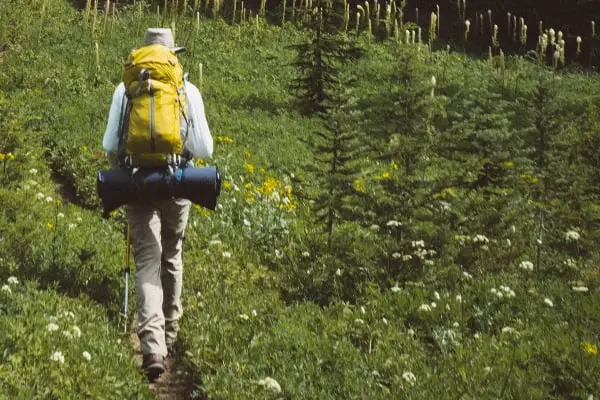
My strategy is to start off by putting my items into two different categories. The first is the items that I’ll only need at night and the second is the items that I’ll need frequent access to. I’ll then organize each category by weight so that I can put all of the infrequently used items in first from heaviest to lightest followed by the other items from heaviest to lightest.
Items like snacks, water bottles, and sunscreen will go in outer pockets so that I can easily gain access to them at any time. When I pack this way, I’ll often be able to go the entire day without opening up my backpack’s main compartment.
How to Wear a Backpack
A backpack should fit tight against your body. Tighten the straps as well as the hip belt so that the backpack does not bounce around while when you walk.
Make sure the hip belt fits directly over your hip bones and that your sternum strap sits about an inch below your clavicles. If you find that your backpack still hangs improperly after you’ve fitted it to your body, check to make sure that your gear is secured tightly inside of your pack.
Sometimes an improper load can be the cause of an uncomfortable backpack. If your gear is sliding around inside, consider compressing it into compression bags so that you can pull the backpack in closer to your body.
Another thought to keep in mind is that you may have to readjust your backpack several times while on your hike. This is normal, especially your first few times out with a new backpack.
It takes time to get used to a new backpack and items can sometimes shift as you make your way down the trail. Taking a few extra minutes to make sure your backpack is comfortable will make a world of difference at the end of the day when your back and shoulders are free from pain.

